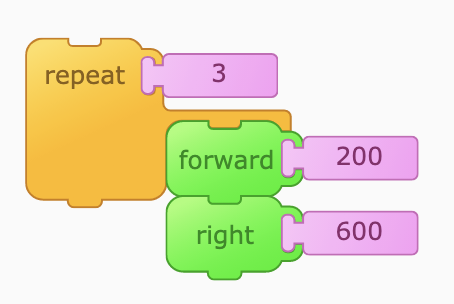Clever Computing for Kids
Documentation from Session #2
Setting: Dr. Gary Stager is leading a class of 4th graders in the Southeast of the United States from his home near Los Angeles via Zoom. He is projected in the front of the room and students each have a laptop running Turtle Art. The students are together in a physical classroom.
Prompt: Program the turtle to draw a triangle with three equal sides.
The teacher then gave students time to work on solving the challenge before asking for kids to share their approach to solving the problem (in the form of a Turtle Art program).
Student:
FORWARD 100
FORWARD 100
RIGHT 100
RIGHT 100
“Now run RIGHT 100 RIGHT 100 again”
“and again”
“Then FORWARD 100 FORWARD 100 again”
RIGHT 100
RIGHT 100
“three times”
FORWARD 100
FORWARD 100
RIGHT 100
RIGHT 100
RIGHT 100
RIGHT 100
RIGHT 100
RIGHT 100
Thoughts
The student is not yet thinking at the pattern or procedural level and is using a lot of repeated addition. The instructions for each of the triangle’s sides were conceptually grouped by the time she shared her approach with the class.
With a little coaxing from me, the student began seeing that FORWARD 100 FORWARD 100 could be simplified as FORWARD 200.
Seeing RIGHT 100 RIGHT 100 three times was more difficult.
A nice feature of the Web-based version of Turtle Art is that you can watcht the silly turtle turning/spinning a lot and tiring itself out.
Other students saw a pattern that led to the creation of
REPEAT 3 [FORWARD 100 RIGHT 600]
The use of RIGHT 600 was selected after I asked students “Should the turtle turn less than or more than 90?”
Eventually, there was a tepid consensus that the turn should be greater than that for a square.
Then I asked, “What number do you think the turn will then be less than?”
A few students reported, “180,” because that’s a U-Turn.
I suspect that a turn of 600, a multiple of 120 greater than 360 (a full rotation), is a concept that will remain elusive for some time.
Note: Despite turning the turtle right, the repeated turns cause the triangle to draw to the left of the initial starting position and orientation. This requires further exploration with the students.
Veteran educator Gary Stager, Ph.D. is the author of Twenty Things to Do with a Computer – Forward 50, co-author of Invent To Learn — Making, Tinkering, and Engineering in the Classroom, publisher at Constructing Modern Knowledge Press, and the founder of the Constructing Modern Knowledge summer institute. He led professional development in the world’s first 1:1 laptop schools thirty years ago and designed one of the oldest online graduate school programs. Gary is also the curator of The Seymour Papert archives at DailyPapert.com. Learn more about Gary here.


